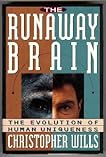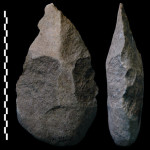September 17, 2011
Book Review: Runaway Brain
 The Runaway Brain: The Evolution of Human Uniqueness
The Runaway Brain: The Evolution of Human Uniqueness
My rating: 5 of 5 stars
In my lifelong effort to understand what makes us human, I long ago arrived at the lynchpin to that discussion: our brain. Even though bipedalism preceded big brains, and we couldn’t be who we are without that upright stance, I believe we would be little more than vertical apes without being followed quickly by an explosion in our brain size. And, I’m not talking about volume–quantity–as much as quality. Neanderthals taught us brain growth must be in the correct part of the brain. Bigger, stronger animals require bigger stronger brains, but that doesn’t mean they are more efficient or effective. Neanderthals had a brain bigger than modern man, but it was used to drive their life style, not their evolution.
It is this topic that Christopher Wills investigates in his wonderful book, The Runaway Brain: The Evolution of Human Uniqueness (Harper Collins 1993). His approach is not so much a simple discussion of our brain’s changes over time as a focus on how those changes turned the genus Homo into the most unique animal on the planet. His writing is fun, easy-to-understand and almost like a thriller as we are forced to turn pages long after we might have put the book down. Why? We must see what happens next. He discusses not only evolution, but brain growth in modern man–how does the brain mature throughout our own lifetime. I learned most of this in my child psychology classes, but reading it through his eyes was so much more fun than the way my professors described it.
The real meat of the book is his discussion of changes in the brain that enabled our evolution to Thinking Man. So much of what we are wouldn’t be possible without drastic changes in the brain’s structure. Mutations, certainly, but we’re thankful for them. Our ability to speak as we do is one. Our interest in art and music–symbolic thinking, where we don’t just say things in a black-and-white sort of way, but use mental pictures. As recently as the early 1900’s, this sort of symbolic thinking allowed primitive tribes to travel their habitat without ever getting lost–even to places they had never before been.
How did we come up with counting? How did we decide to adorn ourselves with paint and jewelry? These would not have occurred without changes in our brain that made these seem normal. Why does man problem-solve? Most other species follow instinct. If there isn’t a solution that’s hard-wired into their genes or they can learn from a parent, it’s out of their reach. Not mankind.
These are all part of the Runaway Brain. Jump in and don’t let go. If you borrow the book from the library, you’ll end up purchasing it because you’ll want to refer to it over and over.
Jacqui Murray is the editor of a technology curriculum for K-fifth grade and creator of two technology training books for middle school. She is the author of Building a Midshipman, the story of her daughter’s journey from high school to United States Naval Academy midshipman. She is webmaster for five blogs, an Amazon Vine Voice book reviewer, a columnist for Examiner.com, an ISTE article reviewer, an IMS tech expert, and a weekly contributor to Write Anything and Technology in Education. Currently, she’s working on a techno-thriller that should be ready this summer. Contact Jacqui at her writing office or her tech lab, Ask a Tech Teacher.






